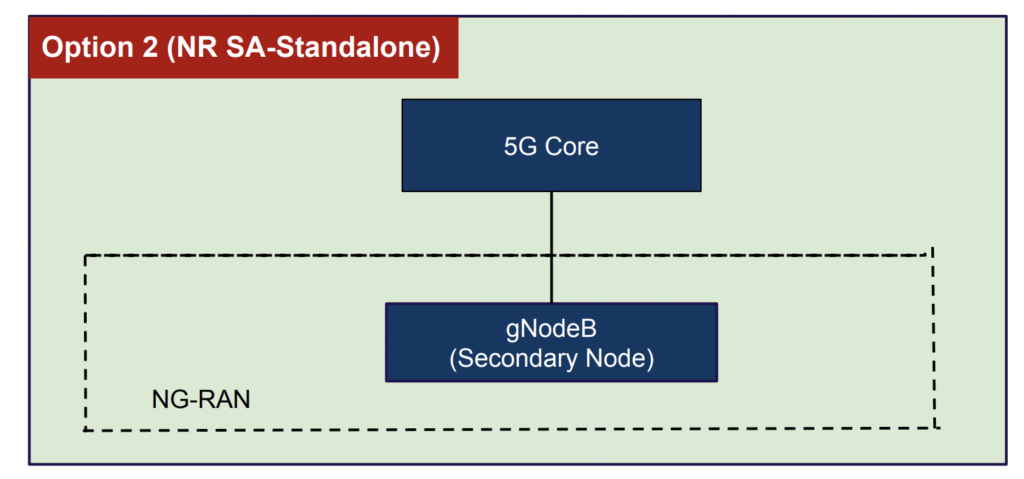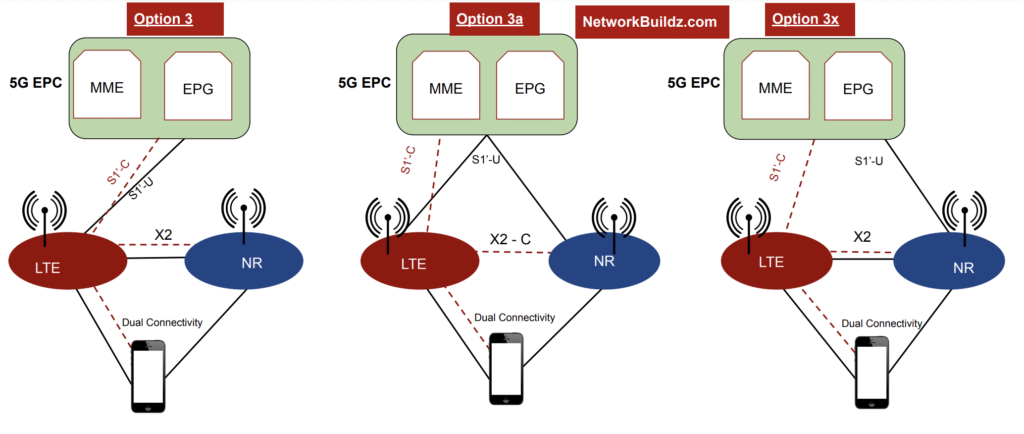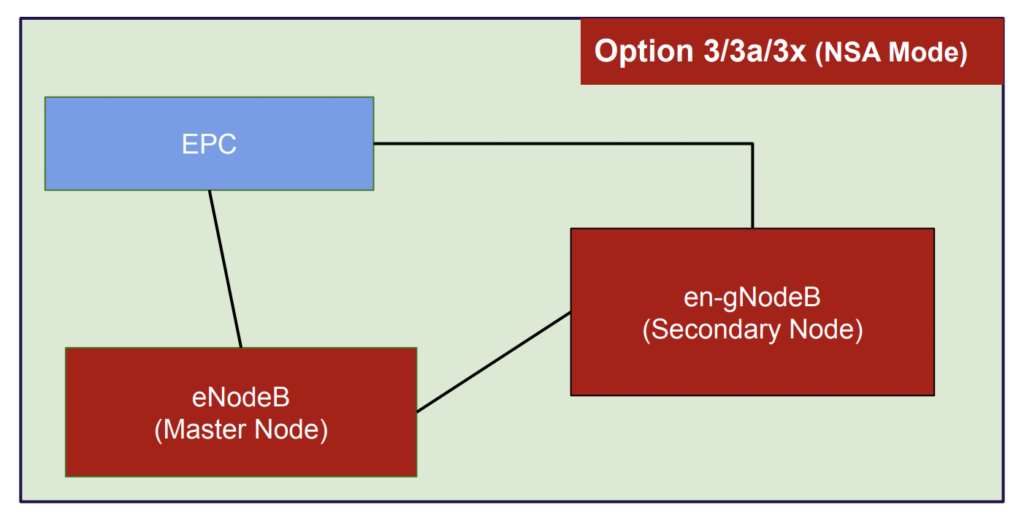3GPP Architecture for 5G offers multiple connectivity options, enabling operators to deploy the network in various ways.
The options range from a standalone LTE network connected to the Evolved Packet Core (EPC) to a non-standalone network that integrates both LTE and 5G New Radio (NR) access technologies controlled by either the EPC or the 5G Core (5GC).
In this article, we would explore various 5G deployment options and their use-cases in in-depth.

5G Deployment is categorized into two options basically:
- Standalone (SA) Deployment
- Non-Standalone (NSA) Deployment
Standalone (SA) Deployment in 5G Networks
In a Standalone (SA) 5G deployment, only one radio access technology is used, either LTE radio or 5G NR. Both the control and user planes are processed through the same RAN element. This deployment mode is relatively straightforward for operators in terms of deployment and network management. Inter-RAT handover is required to ensure service continuity.
5G SA Deployment Mode Options:
Option 1: (EPC + 4G eNB) Option 2: (5GC + 5G gNB) Option 5: (5GC + 4G ng-eNB)
Non-Standalone (NSA) Deployment in 5G Networks
The Non-Standalone (NSA) deployment in 5G networks involves the combination of multiple radio access technologies.
In 5G NSA, The control plane is processed through the master node, while the data plane is split between the master node and a secondary node. There is a tight interworking between the 4G RAN and 5G NR.
5G NSA Deployment Options:
Option 3: (EPC + 4G eNB Primary + 5G en-gNB Secondary) Option 4: (5GC + 5G gNB Primary + 4G ng-eNB Secondary) Option 7: (5GC + 4g ng-eNB Primary + 5g gNB Secondary)
5G Deployment Options: Option 1
5G Deployment Option 1 represents the current 4G (LTE+EPC) deployments, where the LTE radio is connected to the EPC and has no relation with 5G.
Deployment Option 1 does not involve the deployment of 5G technology and is instead a continuation of 4G (LTE) deployments. In this option, the LTE radio is connected to the 4G Evolved Packet Core (EPC) network, and the network does not offer any 5G capabilities.
This deployment option is essentially the legacy deployment of LTE and is currently being used by most operators around the world.
Service providers who choose this option are continuing to operate their networks in the same manner as they did before the introduction of 5G technology.
5G Deployment Options: Option 2
The 5G Deployment Option 2 allows for the implementation of 5G NR (New Radio) technology, with a direct connection to the 5GC (5G Core) network.

This deployment option is ideal for new Communication Service Providers (CSPs) or existing operators seeking to provide 5G-only services without the integration of their existing 4G network.
This deployment approach offers the ability to implement a wide range of 5G use cases, including massive machine type communications (mMTC), enhanced mobile broadband (eMBB), and ultra-reliable low-latency communications (URLLC), provided that adequate spectrum is allocated for each service type.
5G Deployment Options: Option 3, 3a, 3x
In 5G Deployment options 3, 3a, and 3x, both LTE and 5G NR radio access networks are deployed, but only the EPC core, which is connected to the LTE access, controls them.
The LTE access acts as the control plane signaling anchor for 5G NR, and the user data traffic can be delivered to the UE through both LTE and 5G NR using the existing EPC signaling interfaces (S1-U, S1-C).
In 5G option 3, the user plane data is sent from the LTE RAN to the 5G NR, while in option 3a, it is directly transmitted from the EPC to the 5G NR. However, this deployment scenario does not allow for the load sharing of data over a single bearer of 4G and 5G.

For instance, LTE RAT will handle 4G data, such as VoLTE, while 5G NR base stations will be responsible for handling eMBB use cases.
This option may pose challenges in deployment, especially in areas where there is limited 5G NR coverage, as UE moving in and out of 5G coverage could result in inconsistent internet connectivity and a subpar user experience.

Option 3x, in the 5G deployment options, is a combination of options 3 and 3a. In this option, the control plane signaling is anchored in the LTE access network, but part of the user data traffic can be delivered directly from the EPC to the 5G NR, and part can be delivered through the LTE RAN to the 5G NR.
This deployment option provides more flexibility in terms of how the data traffic is handled, but it still requires a stable LTE coverage to ensure a seamless user experience.
Like the other options, the core network signaling used in option 3x is the existing EPC signaling (S1-U, S1-C).
5G Deployment Options: Options 4 and 4a
5G deployment options 4 and 4a use both LTE and 5G NR radio access technologies controlled by the 5GC, with option 4 sending LTE user plane connections through the 5G NR and option 4a directly sending user plane traffic from 5GC to LTE RAN.

In option 4, LTE user plane connections travel through the 5G NR, whereas in option 4a, user plane traffic is sent directly from 5GC to LTE RAN.
The signaling interface is the new 5G core signaling (NG-C and NG-U), requiring enhanced LTE (eLTE) deployment as a requirement for it to deploy.
5G Deployment Options: Options 5
5G deployment option 5 is a type of 5G network deployment scenario where a standalone LTE RAN is connected to the 5G core (5GC) using an evolved LTE (eLTE) RAN that supports the new 5GC signaling.
However, as per latest industry data, network operators are not likely to choose this option as most of the benefits of 5G are achieved through the adoption of a 5G NR access network.
Although the eLTE RAN is capable of supporting the new signalling and allows the network to transition to the next-generation core (NGC), it does not fully realize the potential of 5G. Therefore, this option may not be as attractive to network operators.

This deployment scenario is also referred to as Standalone (SA) Evolved E-UTRA (LTE) in 5G Standalone (5GS), which is suitable for areas where only evolved E-UTRA access systems are present and no legacy LTE systems exist. In such cases, the next-generation eNodeB (ng-eNB) is connected to the 5GC to create a 5G standalone (5GS) network.
5G Deployment Options: Options 6
In 5G Deployment Option 6 scenario, the 5G NR radio network would be fully migrated, but would still use the original EPC signaling interfaces (S1-U, S1-C) to communicate with the EPC.
However, this deployment option is highly unlikely to be adopted by operators due to the presence of LTE radio networks and the gradual migration towards the next generation core (5GC).
As a result, option 6 has been removed from the list of probable options and is not specified in the 3GPP Release 15 specifications more now, meaning 5G devices cannot support this deployment option.
5G Deployment Options: Options 7, 7a, and 7x
5G Deployment Options 7, 7a, and 7x are Non-Standalone deployment options for 5G networks, which utilize the LTE and 5G NR radio both.
To establish communication between the radio network infrastructure and the 5GC, next-generation signaling protocols like NG-U and NG-C will be employed for the core network signaling interface.
The signaling will be routed via the LTE RAN to ensure seamless connectivity. This approach aims to enhance network efficiency and enable faster data transmission speeds while minimizing disruption and downtime.
The main difference between Option 7 and 7a lies in the delivery of user data or user plane traffic to the UE (User Equipment).
In Option 7, the data flows from the 5GC to the 5G NR through the LTE RAN, while in Option 7a, the data flows directly from the 5GC to the 5G NR and then to the UE via the new radio interface.

Option 7x combines the features of Options 7 and 7a, delivering user data partly through the 5G NR and partly via the LTE RAN to the 5G NR, and ultimately to the UE. This approach aims to improve data transmission speeds and enhance connectivity for users, providing a seamless and efficient experience.
All three options require an upgrade to the existing LTE network through eLTE to ensure compatibility with the new 5GC signaling protocols (NG-C, NG-U).
5G SA vs. NSA Deployment Modes
Standalone (SA) Deployment Mode
In a Standalone (SA) 5G network, both the 5G Radio Access Network (RAN) and 5G Core Network (CN) are deployed and operated independently from existing 4G networks, providing a dedicated and optimized network for 5G services.
This deployment mode enables service providers to leverage the full capabilities of 5G, including ultra-high-speed data transfer rates, low latency, and large-scale IoT connectivity.
One of the key benefits of 5G SA is the ability to support new and innovative use cases, such as autonomous vehicles, virtual and augmented reality, and industrial automation, which require the advanced capabilities of 5G.
This deployment mode also enables service providers to offer differentiated 5G services and increase revenue opportunities.
Non-Standalone (NSA) Deployment Mode
In a Non-Standalone (NSA) 5G network, the 5G RAN is deployed and operated in conjunction with existing 4G Evolved Packet Core (EPC) networks, allowing for a gradual introduction of 5G capabilities into the existing network infrastructure.
This deployment mode offers a cost-effective solution for service providers looking to introduce 5G capabilities into their network while maintaining the existing 4G network.
However, it is important to note that this deployment mode may have limitations in terms of the capabilities of 5G services that can be offered and may not support the full range of 5G use cases.
In conclusion, 5G technology offers two main deployment modes: Standalone (SA) and Non-Standalone (NSA), each with its own benefits and considerations. Service providers must carefully evaluate their requirements and choose the deployment mode that best meets their needs.
What are the All Possible Migration Paths From 4G to 5G Network?
There are several possible migration paths from 4G to 5G network, depending on the current infrastructure, technology, and requirements of a particular network.
Most Common 4G to 5G Network Migration Paths are:
1. 4G EPS to SA (Deployment Option 2)
This migration path involves upgrading the existing 4G Evolved Packet System (EPS) infrastructure to a Standalone (SA) 5G network. This approach involves deploying a fully independent 5G network, separate from the 4G infrastructure, which can support a wide range of new and innovative 5G services and applications.
2. 4G EPS to NSA (Deployment option 3)
This migration path involves deploying a Non-Standalone (NSA) 5G network, which leverages the existing 4G EPS infrastructure for data and control plane functions.
In this scenario, the 5G network is deployed as an overlay to the existing 4G network, offering improved performance and capabilities for certain types of services and applications.
3. NSA Option 3 to NSA option 7/SA Option 5
This migration path involves upgrading the existing NSA option 3 network to either a more advanced NSA option 7 network or a standalone SA option 5 network.
This approach enables network operators to enhance their 5G capabilities and performance, offering more advanced and innovative services to their customers.
4. NSA option 3 to NSA option 3/SA option 5
This migration path involves maintaining the existing NSA option 3 network, but also deploying an additional NSA option 3 or standalone SA option 5 network.
This approach enables network operators to offer a mix of 4G and 5G services and technologies, allowing for a smooth and gradual transition to 5G.
5. NSA Option 3 to NSA Option 4
This migration path involves upgrading the existing NSA option 3 network to a more advanced NSA option 4 network. This approach enables network operators to enhance the performance and capabilities of their 5G network, improving support for a wider range of services and applications.
The actual migration path will depend on various factors such as the existing network infrastructure, the availability of spectrum, the type of services and applications that need to be supported, and the cost and complexity of upgrading the existing network for a particular customer.
A thorough analysis of customer network would only help you to decide that which migration path will be the best fit to migrate the services.
Conclusion
In conclusion, there are multiple options available for 5G deployment, and each option offers different benefits and trade-offs. When choosing a deployment option, operators must consider their existing network infrastructure, the types of use cases they wish to support, and the cost and complexity of deployment.
Standalone (SA) deployment options, such as options 1, 2, 5, and 6, provide a fully independent 5G network, but require a complete replacement of the existing LTE and EPC infrastructure. This can be a costly and complex process, especially for operators with existing LTE and EPC networks.
Non-Standalone (NSA) deployment options, such as options 3, 3a, 3x, 4, 4a, 7, 7a, and 7x, provide a more incremental approach to 5G deployment, as they retain the existing LTE and EPC infrastructure while adding 5G capabilities. This reduces the cost and complexity of deployment, but also limits the full benefits of 5G.
When choosing a deployment option, it is important to consider the specific needs and requirements of the operator, as well as the available spectrum and technology.
With the right deployment option, operators can maximize the benefits of 5G and provide a seamless and high-quality user experience for their customers.